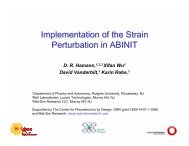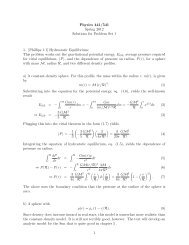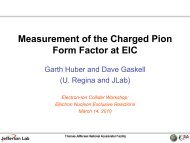examexample - Department of Physics and Astronomy
examexample - Department of Physics and Astronomy
examexample - Department of Physics and Astronomy
You also want an ePaper? Increase the reach of your titles
YUMPU automatically turns print PDFs into web optimized ePapers that Google loves.
Writing Exams in (La)TEX<br />
for use with GRTEX<br />
Joel A. Shapiro<br />
March 23, 1997<br />
Copyright c○ 1993, 1995, 1997, 2003 by Joel A. Shapiro<br />
⇒<br />
Your name sticker with exam code<br />
⇐<br />
1. These are instructions for preparing exams in latex (or tex) in a<br />
way which will be compatible with the program GRTEX, which<br />
makes multiple versions, each containing selected questions with<br />
the questions <strong>and</strong>/or answers in permuted orders. But these instructions<br />
are formatted to look like an exam.<br />
2. That way, the input for this file, called <strong>examexample</strong>.tex, can<br />
serve as an example as well as serving as instructions. You can<br />
copy examex.template, which is a template into which you can<br />
insert your own material.<br />
3. You will see that the format provides several options for the style<br />
<strong>of</strong> questions, both with <strong>and</strong> without accompanying figures. One<br />
waytolearnhowtomakeanexamtoyourlikingistoexamine<br />
this example, select the styles you want to use, copy this file <strong>and</strong><br />
change the text to say what you want.<br />
4. You can also change from two column to one column, portrait<br />
style, by uncommenting the indicated line (see the source file). To<br />
print this file as a source file, type enscript -G <strong>examexample</strong>.tex<br />
(on a Sun, or whatever you use to print an ordinary ASCII file<br />
on other machines) rather than L A TEXing it. Another option you<br />
can choose is to have the pages numbered, by uncommenting a<br />
different line.<br />
5. You will need a question file in a format like this one, which is<br />
suitable for TEXing or L A TEXing. It is also suitable for grtex,<br />
when taken together with a want file,which contains information<br />
for GRTeX such as which questions will be used <strong>and</strong> the style <strong>of</strong><br />
permutation. The want file is described in detail in the GRTeX<br />
writeup. The program grtex will ask you for the names <strong>of</strong> these<br />
files <strong>and</strong> <strong>of</strong> the output files, one <strong>of</strong> which can then be TEXed or<br />
L A TEXed, <strong>and</strong> the other <strong>of</strong> which is an answer key input to GRAD<br />
or GRED or grfix.<br />
6. Most instructors like to have a cover page, <strong>and</strong> not have any exam<br />
problems on the first sheet. This leaves room for a page <strong>of</strong> instructions<br />
<strong>and</strong> a page <strong>of</strong> formulas <strong>and</strong> constants. In two column style, I<br />
call each column a page. To deliberately end the page, as I did after<br />
item 5, use \eject or \vfill\eject. To make sure to end the<br />
whole side, even in two column mode, use \clearpage instead.<br />
7. Please note that TEX, L A TEX, <strong>and</strong> emacs cannot be used directly<br />
on encrypted files. Unfortunately this means that the input <strong>and</strong><br />
output will, at least temporarily, be on the disk in cleartext on<br />
the computer. Be very careful that exam files are secret in a<br />
subdirectory that is secret. They can be encrypted at all times<br />
except just around the TEXing <strong>and</strong> the printing.<br />
8. This file requires L A TEX <strong>and</strong> calls on the files epsf.tex,<br />
exammac.tex <strong>and</strong> exammac2.tex, which must be in the path searched<br />
by L A TEX. On the public Suns this should be the case without your<br />
taking any action.<br />
9. The available question formats are introduced starting with “Question”<br />
1. The rules required for a good latex (or tex) file to be<br />
compatible with grtex are spelled out in “Question” 24. Hints<br />
for databases are in “Question” 33.<br />
Elementary charge e =1.6 × 10 −19 C,<br />
Electron charge = −e.<br />
1<br />
=9× 10 9 N · m 2 /C 2 , ɛ 0 =8.85 × 10 −12 C 2 /N · m<br />
4πɛ 0<br />
Mass <strong>of</strong> electron = 9.11 × 10 −31 kg<br />
Mass <strong>of</strong> proton = 1.67 × 10 −27 kg<br />
1 electron volt (eV) = 1.6 × 10 −19 J
1. The sections <strong>of</strong> these instructions are to be found as follows<br />
a) Instructions for writing individual questions: “Question” 4<br />
b) Instructions for the grtex input question file: “Question”<br />
24<br />
c) References to other documentation on grtex, grad, grek,<br />
etc.: “Question” 37<br />
d) Suggestions for maintaining a database <strong>of</strong> questions: “Question”<br />
33<br />
e) Suggestions for getting started: The “tail” after “Question”<br />
37<br />
2. The programs grtex, gread, gred, <strong>and</strong> grad currently (Oct,<br />
2003) support two kinds <strong>of</strong> exams. The traditional exam form<br />
permits up to 200 multiple choice questions. The newer form<br />
permits up to 15 numerical answer questions <strong>and</strong> up to 30 multiple<br />
choice questions.<br />
a) The mark-sense forms for multiple choice questions <strong>and</strong> for<br />
numerical answer questions are totally different<br />
b) Multiple choice questions are discussed beginning with “Question”<br />
4<br />
c) Multiple choice with accompanying pictures start with “Question”<br />
11<br />
d) Multiple choice with answer choices on the pictures start<br />
with “Question” 22<br />
e) Numerical answer questions are discussed starting with “Question”<br />
28<br />
Finally we have some comments on things you can insert into all<br />
questions, starting with “Question” 32.<br />
3. All <strong>of</strong> the questions on the exam must appear together, with no<br />
intermediate material, although there can be material before all<br />
the questions <strong>and</strong> after all the questions. Each question is a separate<br />
paragraph, that is, there is at least one blank line before <strong>and</strong><br />
after each question.<br />
a) MC next b) MC pictures at 11 c) numerical at 28<br />
d) file format at 24<br />
4. Each <strong>of</strong> the multiple-choice questions must be given in a very particular<br />
form, with exactly the eight components described below.<br />
Each must start in the first column <strong>of</strong> a new line † . Comments<br />
may be placed as desired. ∗ Each question appears as follows:<br />
a) The TEX comm<strong>and</strong> \setup with argument #1 containing<br />
the question number <strong>and</strong> #2 the correct answer:<br />
\setup{27}{2}. The initial \ must be placed in column 1.<br />
b) The question, enclosed in braces. If the question takes more<br />
than one line, it is recommended that following lines in the<br />
source code be indented for clarity. The final brace should<br />
be followed by a % <strong>and</strong> a newline.<br />
c) Five answers, enclosed in braces, with the opening brace in<br />
column 1. An argument’s closing } must be followed by a<br />
newline.<br />
d) A TEX comm<strong>and</strong> <strong>of</strong> the form \xxxquest, possibly followed<br />
by arguments, with the initial \ in column 1.<br />
e) It is essential that the setup have exactly 8 arguments,<br />
<strong>and</strong> that there be no intermediate (uncommented) spaces<br />
or other material between them. The meanings <strong>of</strong> the arguments<br />
are given in the next question. The choices <strong>of</strong><br />
\xxxquest are given in the question after that.<br />
† Well, certainly not the second <strong>and</strong> third. What the true restrictions<br />
are needs to be clarified.<br />
∗ As <strong>of</strong> June, 1996, tex comments within questions were causing<br />
some problems.<br />
5. The arguments to the \setup macro are<br />
a) #1 is a number (integer) identifying the question in the<br />
“want” file. It will be replaced by GRTEX with the number<br />
to appear as the question number on the exam.<br />
b) #2 is the correct answer, one <strong>of</strong> 1, 2, 3, 4, or 5<br />
c) #3 is the text <strong>of</strong> the question, which may include any TEX<br />
or L A TEX code which makes sense. In all styles <strong>of</strong> question,<br />
this is set above the answers.<br />
d) #4–#8 are the five answers, without a leading letter or<br />
number. There must be five arguments here even if you<br />
use a question format with fewer answer choices.
6. The first question was <strong>of</strong> the form \stdquest, which has no attached<br />
figure, has the question statement set above the answers,<br />
which are in an itemized list below the question. So was Question<br />
#4, but that one also had a footnote added with an undernote,<br />
a feature added Nov. ’96 to all forms <strong>of</strong> questions, <strong>and</strong> explained<br />
in question 32 below. Question #5 used \fourquest, whichis<br />
the same thing except the student is presented with only four answers.<br />
I don’t encourage this, but it is available. The other forms<br />
<strong>of</strong> question available on May 11, 1993 were<br />
a) \lilquest<br />
b) \ivlquest<br />
c) \pixquest<br />
d) \lpixquest<br />
e) \fpixquest<br />
But in Nov. 1996 I added \mvaquest <strong>and</strong> \lmvaquest, <strong>and</strong> in<br />
Jan. 2003, I added the numerical question styles numquest,<br />
numsidepix, <strong>and</strong>numbotpix<br />
7. This is an example <strong>of</strong> lilquest.<br />
Two large parallel conducting plates are 10 cm apart <strong>and</strong> carry<br />
equal but opposite charges on their facing surfaces. An electron<br />
placed midway between the plates experiences a force <strong>of</strong> 3.2×10 −17<br />
N. The potential difference between the plates is<br />
a) 2000 V b) 200 V c) 40 V d) 20 V<br />
e) 10 V<br />
8. Two capacitors have capacitances <strong>of</strong> 7µF <strong>and</strong>5µF respectively.<br />
They are connected in parallel to a battery. After the battery has<br />
charged them, the 7µF-capacitor has a stored energy <strong>of</strong> 2.24 ×<br />
10 −4 J. What is the charge on the other capacitor, i.e. the 5µFcapacitor?<br />
a) 40µC<br />
b) 96µC<br />
c) Zero<br />
d) 56µC<br />
e) stdquest questions are just so beautiful!<br />
9. A parallel-plate capacitor is charged <strong>and</strong> then disconnected from<br />
the charging battery. A dielectric slab is inserted in the gap between<br />
the capacitor plates. As a result,<br />
a) the capacitance stays the same, while the electric field decreases<br />
b) the capacitance stays the same, while the electric field increases<br />
c) the capacitance <strong>and</strong> electric field both increase<br />
d) the capacitance increases, while the electric field decreases<br />
e) the capacitance <strong>and</strong> electric field both decrease<br />
10. This is a ivlquest. Noteiv is four, <strong>and</strong> l is for little.<br />
A charge <strong>of</strong> +6.0 nC is at the origin, <strong>and</strong> another charge <strong>of</strong> +6.0<br />
nC is on the x-axis at x = 1.0 m. If the potential is chosen to be<br />
zero at infinity, what is the value <strong>of</strong> the potential on the y-axis at<br />
y=1.0m?<br />
a) 15.8 V b) 108 V c) 92.2 V d) 85.4 V<br />
11. Two conducting, hollow spheres have different radii. A thin, conducting<br />
wire connects the spheres. A charge Q is placed on the<br />
smaller sphere. Then,<br />
a) charge will flow until the spheres have equal<br />
potentials.<br />
b) charge will flow until the spheres have equal<br />
charges.<br />
c) all <strong>of</strong> the charge will flow to the larger<br />
sphere.<br />
d) charge will flow until the spheres have equal<br />
electric fields at their surfaces.<br />
e) There will be no flow <strong>of</strong> charge, so the<br />
charge Q will remain on the smaller sphere.
12. Note that the last question had a figure attached. It was a question<br />
<strong>of</strong> type pixquest, <strong>and</strong> had the 8 arguments to \setup,<br />
followed by \pixquest{1in}{227f90h1.ps1}.<br />
a) The \pixquest macro requires two arguments <strong>of</strong> its own,<br />
unlike \stdquest, \fourquest, \lilquest <strong>and</strong> \ivlquest,<br />
which didn’t require arguments.<br />
b) The first argument is the width <strong>of</strong> the figure to be included.<br />
This should not be very large, or there will be insufficient<br />
room for the answers to format decently.<br />
c) The second argument is the name <strong>of</strong> a file containing a<br />
postscript figure to be inserted. Note that it has been given<br />
a unique name. This figure was the first figure on the first<br />
hour exam in 227 in fall, 1990.<br />
d) I hope that people will make their exams available to the<br />
department after giving them. I have put together several<br />
big files <strong>of</strong> questions. As these files are large enough, people<br />
might reuse some <strong>of</strong> the questions.<br />
e) There are currently two other styles <strong>of</strong> questions with figures<br />
other than those with answers on them (Q22). See<br />
Q14 <strong>and</strong> Q17.<br />
14. In the preceding problem, the figure was to the right <strong>of</strong> everything,<br />
<strong>and</strong> both the question <strong>and</strong> the answers were set narrower than<br />
usual.<br />
a) It was set with lpixquest, where the l st<strong>and</strong>s for long.<br />
b) lpixquest takes the same two arguments as pixquest.<br />
c) The decision which form to use depends on how high the<br />
picture will be, <strong>and</strong> how much space will be taken by the<br />
answers alone, <strong>and</strong> how much by the answers <strong>and</strong> question<br />
together.<br />
d) For the last problem, the figure was fairly tall, the answers<br />
didn’t take much space, but the question statement<br />
together with the answers took as much vertical space as<br />
the figure. So lpixquest was just what was needed.<br />
15. In the preceding problem, the charge on the surface <strong>of</strong> the shell<br />
at r = R 1 is<br />
a) Zero b) − 5Q<br />
e)<br />
7Q<br />
r 2 ˆr<br />
ˆr c) −2Q<br />
r2 r ˆr d) 3Q<br />
2 r ˆr 2<br />
13. A charge <strong>of</strong> +5Q is at the origin.<br />
Concentric with it is a conducting<br />
spherical shell <strong>of</strong> inner radius R 1<br />
<strong>and</strong> outer radius R 2 . This shell is<br />
given a net charge <strong>of</strong> −2Q. The<br />
distance r is measured from the origin.<br />
In the region r > R 2 , the<br />
electric field is 1/4πɛ 0 times<br />
a) [−2Q/r 2 ]ˆr<br />
b) [3Q/r 2 ]ˆr<br />
c) [5Q/r 2 ]ˆr<br />
d) [7Q/r 2 ]ˆr<br />
e) Zero<br />
-2Q<br />
R<br />
2<br />
+5Q<br />
R<br />
1<br />
16. In the preceding problem, the charge on the surface <strong>of</strong> the shell<br />
at r = R 2 is<br />
a) Zero b) −2Q c) −5Q d) +3Q<br />
17. Consider two points A <strong>and</strong> B. An electric field points from B<br />
towards A, <strong>and</strong> is constant in magnitude, so that E B = E A .How<br />
are the electric potentials at A <strong>and</strong> B related?<br />
a. V B = V A<br />
b. V B >V A<br />
A<br />
B<br />
c. V B
18. In the last problem, the figure was very short, <strong>and</strong> some <strong>of</strong> the<br />
answers long enough so they need to wrap when next to the picture.<br />
Note that the figure was set next to the first four answers,<br />
<strong>and</strong> the last one didn’t need to wrap. The \fpixquest macro figured<br />
this out by itself. Permutation <strong>of</strong> the answers would still be<br />
treated properly, although if the current “d” <strong>and</strong> “e” were the first<br />
two, they would both wrap <strong>and</strong> there would be no advantage over<br />
pixquest, except the picture would appear higher. fpixquest<br />
proves that<br />
a) TEX is marvelously flexible.<br />
b) TEX isoverlycomplex.<br />
c) Anyone who writes his exams using wordmark has no sense<br />
<strong>of</strong> quality.<br />
d) Joel is crazy to have spent 8 hours getting fpixquest to<br />
work.<br />
e) All <strong>of</strong> the above.<br />
19. The equivalent capacitance <strong>of</strong> the<br />
three capacitors is<br />
a) 0.16µF<br />
b) 0.19µF<br />
c) 1.00µF<br />
d) 5.20µF<br />
e) 6.25µF<br />
1.0 µ F 4.0 µ F<br />
0.2 µ F<br />
20. The pixquest <strong>and</strong> lpixquest can<br />
be called with empty.ps as the second<br />
argument, as in<br />
\pixquest{1in}{empty.ps}. This<br />
leaves space but does not insert a<br />
figure. If the shape is not right,<br />
you can edit the BoundingBox in<br />
empty.ps. Youcanalsouse<br />
thinempty.ps, which is 100 times<br />
higher than it is wide to set aside<br />
extra vertical space for a question.<br />
A width <strong>of</strong> 0.04in reserves 4 vertical<br />
inches for the question.<br />
Canthisbedonewith\fpixquest?<br />
a) No<br />
b) No!<br />
c) No!!<br />
d) No!!!<br />
e) What would be the point?<br />
21. A charge <strong>of</strong> +2.0µC isfixedonthe<br />
x-axis at x = 3 cm, while a charge<br />
<strong>of</strong> −3.0µC is fixed on the y-axis at<br />
y = 3 cm. The force on a third<br />
charge <strong>of</strong> −1.0µC placed at the origin<br />
−3µ C<br />
is <strong>of</strong> magnitude<br />
II<br />
a) 10 N<br />
3cm<br />
b) 20 N<br />
c) 30 N<br />
d) 50 N<br />
−1µC 3cm<br />
e) 36.1 N III<br />
IV<br />
I<br />
+2µ C
22. Sometimes the five answers might be best indicated by placing the<br />
(a), (b), etc. at the right locations on a figure. This is the function<br />
<strong>of</strong> the question style mvaquest (for “move answers”). The positions<br />
are indicated in place <strong>of</strong> textual answers in the five answer<br />
arguments to setup. For example, in this problem the first two<br />
answers are indicated by<br />
{\placeit 100,152 }<br />
{\placeit 180,97 }<br />
The spaces <strong>and</strong> lack there<strong>of</strong> are essential — the two coordinates,<br />
given in points (1/72 <strong>of</strong> an inch), must be separated by a comma<br />
<strong>and</strong> no spaces, <strong>and</strong> the second argument must be followed by a<br />
space.<br />
I<br />
0 0<br />
d<br />
e<br />
a<br />
This format requires adjustment by h<strong>and</strong> <strong>of</strong> the positions. These<br />
adjustments do not currently survive a switch from one column<br />
to two column mode. Any TEX hackers are encouraged to fix this<br />
bug, <strong>and</strong> inform me.<br />
Note mvaquest takes one argument, the file name <strong>of</strong> the picture,<br />
so this question ended with \mvaquest{mvapix.eps}<br />
b<br />
c<br />
t<br />
23. You also might want to have the<br />
figure on the right <strong>of</strong> the question,<br />
with the answers (a)—(e) appearing<br />
on the figure, as with mvaquest.<br />
This question is <strong>of</strong> that type. Note<br />
that the placement adjusted for one<br />
type is unlikely to work for the other.<br />
Note also that this format requires<br />
a width as well as the file name<br />
for the figure. This question ended<br />
with \lmvaquest{2in}{mvapix.eps}<br />
24. Here are the rules for the format <strong>of</strong> the exam so that GRTEX<br />
will be able to do what it has to. Note they still permit immense<br />
flexibility<br />
a) The file begins with a latex header. This should include all<br />
the material needed to set things up, which does not need<br />
to be repeated for each version. It needs to be ended with<br />
a line that says exactly<br />
%%End <strong>of</strong> header<br />
b) Next should follow all the material before the questions,<br />
which is to be repeated on each version <strong>of</strong> the exam. It<br />
must not have the comm<strong>and</strong> \setup in it starting in column<br />
1 or 2.<br />
c) Then follows any number <strong>of</strong> questions, separated by blank<br />
lines, each beginning with \setup, followed by exactly eight<br />
arguments, then followed by a question formatting macro<br />
\???quest, followed by the correct number <strong>of</strong> arguments<br />
for that style question.<br />
d) After all the questions there must be a line that says exactly<br />
% end <strong>of</strong> exam questions.<br />
Then can follow any material which should follow the questions<br />
on each version.<br />
e) Finally, the file ends with<br />
{<br />
\bye for TEX<br />
\end{document} for L A TEX<br />
I<br />
0 0<br />
d<br />
e<br />
a<br />
b<br />
c<br />
t
25. There are other possible styles which should probably be developed.<br />
a) You could design additions to exammac.tex.<br />
b) You could find a student to do it for you.<br />
c) You could make do with the styles I’ve provided.<br />
d) You can include the picture directly in the question text.<br />
Note that the answers can also have figures included. These<br />
will move with the answer when permutted.<br />
e) You could give a clear description <strong>of</strong> the required style <strong>and</strong><br />
a convincing argument for why I should spend the time<br />
creating it.<br />
26. For a certain charge distribution, the potential as a function <strong>of</strong> r<br />
is given by<br />
Q(3R − r)<br />
V (r) = for r
31. This is a numbotpix<br />
λ<br />
32. In November, 1996, I added the capability to add a footnote to<br />
each question — something which appears after the answers on<br />
a full line. As it is expected to be used rarely, I did not want<br />
to build a ninth argument into setup. So, if you want a question<br />
footnote<br />
a) You insert a tex comm<strong>and</strong> \gdef\undernote{Text <strong>of</strong> footnote}<br />
into the question statement.<br />
b) Then you follow the question statement, as usual, with the<br />
answers, the \xxxquest, <strong>and</strong> any arguments that form <strong>of</strong><br />
question may have.<br />
c) This feature is now available with all the question styles.<br />
d) (A useless fourth comment.)<br />
This is a question footnote.<br />
y<br />
x<br />
x<br />
33. In order to make a database <strong>of</strong> exam questions more useful, it<br />
is good to be able to track where the questions originated, what<br />
material is covered, how the students performed (including which<br />
wrong answers were popular), <strong>and</strong> why certain wrong answers<br />
were used as “distractors”. To do this, two tex macros, \attrib<br />
<strong>and</strong> \explain have been added to exammac2.tex.<br />
[#33: Joel Shapiro, not covered in Serway,<br />
227f03h1:0 (16,13,18,51*,3)]<br />
a) \attrib is intended to come at the end <strong>of</strong> the question<br />
statement. It should give authorship, physics topic covered,<br />
exam used, <strong>and</strong> performance statistics.<br />
b) The above question statement ended with:<br />
to {\tt exammac2.tex}. \attrib{ Joel Shapiro, not<br />
covered in Serway, 227f03h1:0 (16,13,18,51*,3)}}<br />
c) The performance statistics should be a parenthesized list,<br />
<strong>of</strong> the percentage <strong>of</strong> students giving each answer, with the<br />
correct answer starred.<br />
d) Of course this needs to be turned <strong>of</strong>f for the real exam. See<br />
the next question.<br />
34. The \explain macro should appear in each answer.<br />
a) \explain is intended to tell why each answer is a good answer<br />
to present. [like this]<br />
b) The explanation in the last answer was included by ending<br />
the last answer with:<br />
to present.\explain{like this}}<br />
c) Of course explain <strong>and</strong> attrib must be turned <strong>of</strong>f for<br />
the real exam. When \realexamtrue, the explain <strong>and</strong><br />
attrib comm<strong>and</strong>s, with their arguments, produce no output.<br />
d) To get the attrib <strong>and</strong> explain comments to show up, the<br />
comm<strong>and</strong> \realexamfalse needs to appear uncommented<br />
in the exam header.
35. Here is an example:<br />
A uniform surface charge density <strong>of</strong> +5.0 nC/m 2 is distributed<br />
over the entire xy-plane. Consider a spherical (radius = 0.050 m)<br />
surface centered on the origin. Determine the electric flux through<br />
this spherical surface.<br />
[#35: #11; Question only from Saunders TestBank<br />
24.6 on 24.2, edited slightly.<br />
227f96h1:6 (33*,38,11,7,11)]<br />
a) 4.44 Nm 2 /C [πr 2 σ/ɛ 0 ]<br />
b) 17.74 Nm 2 /C [4πr 2 σ/ɛ 0 ]<br />
c) 0.296 Nm 2 /C [4πr 3 σ/3ɛ 0 ]<br />
d) 45.0 Nm 2 /C [k e σ]<br />
e) 1.8 × 10 4 Nm 2 /C [k e σ/r 2 ]<br />
36. The database for a course can get quite large, <strong>and</strong> some thought<br />
should be given to how to structure it. I believe it is useful to<br />
have a directory structure something like what is shown here:<br />
99f<br />
203<br />
root<br />
directory<br />
... 228<br />
... 03s eps figs<br />
database<br />
a) The “question” file for grtex would be in the database directory,<br />
<strong>and</strong> would contain all the questions. Any figures referred<br />
to in a question would be referenced as {../eps/figurefile}<br />
b) The question file would contain \input cover.tex <strong>and</strong><br />
\input tail.tex in the appropriate places, before <strong>and</strong> after<br />
the questions. It might also contain an input options.tex.<br />
c) Each semester has its own directory, which will contain the<br />
files cover.tex, tail.tex <strong>and</strong> options.tex for the current<br />
exam. It also contains the “want” file for the exam.<br />
d) To make an exam, one changes directory to that for the<br />
current semester, <strong>and</strong> executes grtex. When asked for the<br />
FILE FOR Questions, give ../database/filename so as to<br />
get the file from the database directory.<br />
e) Note that if you expect to share questions <strong>and</strong> figures among<br />
different courses, you might eliminate the course layer in<br />
the directory structure.
37. Here are some other documents relevant for computer assisted<br />
exams <strong>and</strong> record keeping.<br />
[#37: As <strong>of</strong> Oct. 24, 2003]<br />
a) This file, the template, <strong>and</strong> the pictures used are in<br />
/physics/doc/physics/grading/grtex on the Suns.<br />
b) GRTeX, by Richard J. Plano, explains how to use the grtex<br />
program which produces multiple versions <strong>of</strong> the exam. It<br />
also discusses other aspects <strong>of</strong> the GREAD/GRED/GRAD/GREK<br />
assembly <strong>of</strong> programs.<br />
c) /physics/doc/physics/grading/grek unix contains a number<br />
<strong>of</strong> files by Mohan Kalelkar explaining the use <strong>of</strong> GREK.<br />
d) /physics/doc/physics/grading/grtex/grtex.* contains<br />
older instructions by Joel Shapiro for using grtex. This<br />
predates the numerical questions <strong>and</strong> does not include them.<br />
Getting Started<br />
The instructions above provide a very rich set, probably too<br />
rich, <strong>of</strong> options for a beginning grtex exam writer. I suggest you<br />
start by producing a simple exam. You could start with the template<br />
examex.template. If you have cover page material, enter it<br />
after the line<br />
% enter your cover page material here, if you want one.<br />
but if not, comment out the line \clearpage so it reads<br />
% \clearpage<br />
Then enter a set <strong>of</strong> questions after the line<br />
% enter your exam questions here. ##########<br />
<strong>and</strong> before the line<br />
% end <strong>of</strong> exam questions.<br />
Finally, if you have material to go after all the questions, enter it<br />
just before the clearpage at the end <strong>of</strong> the file.


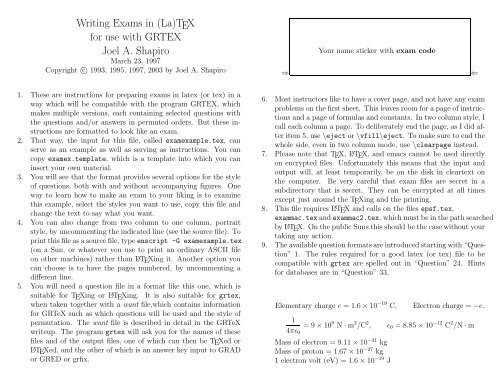

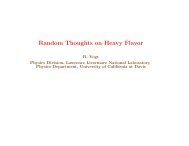
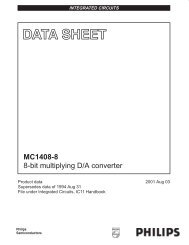

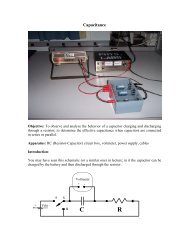

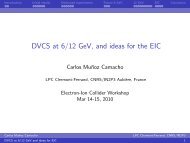
![More Effective C++ [Meyers96]](https://img.yumpu.com/25323611/1/184x260/more-effective-c-meyers96.jpg?quality=85)


